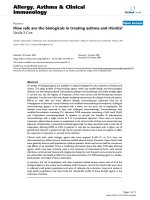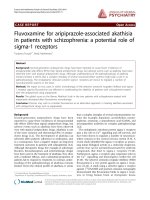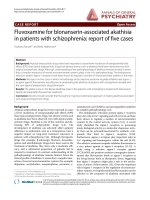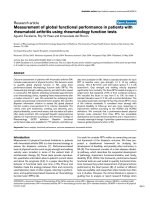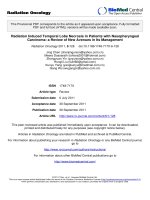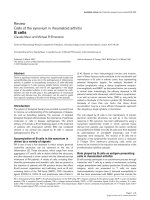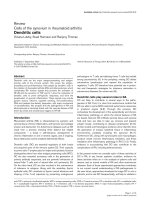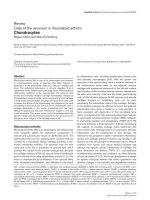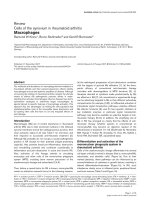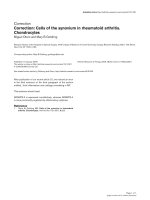Báo cáo y học: "Levosimendan for resuscitating the microcirculation in patients with septic shock: a randomized controlled study" pptx
Bạn đang xem bản rút gọn của tài liệu. Xem và tải ngay bản đầy đủ của tài liệu tại đây (369.8 KB, 11 trang )
RESEARC H Open Access
Levosimendan for resuscitating the
microcirculation in patients with septic shock:
a randomized controlled study
Andrea Morelli
1*
, Abele Donati
2
, Christian Ertmer
3
, Sebastian Rehberg
3
, Matthias Lange
3
, Alessandra Orecchioni
1
,
Valeria Cecchini
1
, Giovanni Landoni
4
, Paolo Pelaia
2
, Paolo Pietropaoli
1
, Hugo Van Aken
3
, Jean-Louis Teboul
5
,
Can Ince
6,7
, Martin Westphal
3
Abstract
Introduction: The purpose of the present study was to investigate microcirculato ry blood flow in patients with
septic shock treated with levosimendan as compared to an active comparator drug (i.e. dobutamine). The primary
end point was a difference of ≥ 20% in the microvascular flow index of small vessels (MFIs) among groups.
Methods: The study was designed as a prospective, randomized, double-blind clinical trial and performed in a
multidisciplinary intensive care unit. After achieving normovolemia and a mean arterial pressure of at least 65
mmHg, 40 septic shock patients were randomized to receive either levosimendan 0.2 μg·kg
-1
·min
-1
(n = 20) or an
active comparator (dobutamine 5 μg·kg
-1
·min
-1
; control; n = 20) for 24 hours. Sublingual microcirculatory blood
flow of small and medium vessels was assessed by sidestream dark-field imaging. Microcirculatory variables and
data from right heart catheterization were obtained at baseline and 24 hours after randomization. Baseline and
demographic data were compared by means of Mann-Whitney rank sum test or chi-square test, as appropriate.
Microvascular and hemodynamic variables were analyzed using the Mann-Whitney rank sum test.
Results: Microcirculatory flow indices of small and medium vessels increased over time and were significantly
higher in the levosimendan group as compared to the control group (24 hrs: MFIm 3.0 (3.0; 3.0) vs. 2.9 (2.8; 3.0);
P = .02; MFIs 2.9 (2.9; 3.0) vs. 2.7 (2.3; 2.8); P < .001). The relative increase of perfused vessel density vs. baseline was
significantly higher in the levosimendan group than in the control group (dMFIm 10 (3; 23)% vs. 0 (-1; 9)%;
P = .007; dMFIs 47 (26; 83)% vs. 10 (-3; 27); P < .001). In additio n, the heterogeneity index decreased only in the
levosimendan group (dHI -93 (-100; -84)% vs. 0 (-78; 57)%; P < .001). There was no statistically significant correlati on
between systemic and microcirculatory flow variables within each group (each P > .05).
Conclusions: Compared to a standard dose of 5 μg·kg
-1
·min
-1
of dobutamine, levosimendan at 0.2 μg·kg
-1
·min
-1
improved sublingual microcirculatory blood flow in patients with septic shock, as reflected by changes in
microcirculatory flow indices of small and medium vessels.
Trial registration: NCT00800306.
Introduction
Microvascular dysfunction plays a pivotal role in the
pathophysiology o f septic shock and may occur even in
the presence of normal systemic oxygen supply and
mean arterial pressure [1]. In this regard, several
vasoactive agents, including inotropes, vasodilators, a nd
inodilators, have been investigated in the attempt to pre-
serve or improve microcircu latory blood flow in patients
with severe sepsis or septic shock [1-5].
In recent years, much attention has been paid to the
use of the calcium sensitizer levosimendan in the treat-
ment of septic myocardial dysfunction [6-10]. Levosi-
mendan increases myocardial contractility while
simultaneously exerting vasodilatory properties via
* Correspondence:
1
Department of Anesthesiology and Intensive Care, University of Rom e,
‘La Sapienza’, Viale del Policlinico 155, Rome 00161, Italy
Full list of author information is available at the end of the article
Morelli et al. Critical Care 2010, 14:R232
/>© 2010 Morelli et al.; licensee BioMed Central Ltd. This is an open access article distributed under the terms of the Creative Commons
Attribu tion License ( .0), which permits unrestricted use, distribution, and reproduction in
any medium, provided the original work is properly cited.
activation of ATP-dependent potassium channels (K
ATP
)
[11]. In addition, levosimendan exerts anti-ischemic,
anti-inflammatory, and anti-apoptotic properties,
thereby affecting important pathways in the pathophy-
siology of septic shock [12-14]. It has been speculated
that, owing to these beneficial effects, levosimendan may
positively affect myocardial performance and regional
hemodynamics, thereby improving microcirculatory per-
fusion [6-10,12,15,16].
The objective of the present randomized controlled,
double-blinded clinical study was, therefore, to elucidate
the effects of levosimendan on systemic and microvascu-
lar hemodynamics. On this basis, we aimed at rejecting
the null hypothesis that there is no difference in sublin-
gual microvascular blood flow - as measured by side-
stream dark-field (SDF) imaging [ 17] - in patients w ith
fluid-resuscitated septic shock treated with levosimen-
dan as compared with an active comparator drug (that
is, dobutamine).
Materials and methods
Patients
After approval by the local institutional ethics commit-
tee, the study was performed in an 18-bed multidisci-
plinary intensive care unit (ICU) at the Department of
Anesthesiology and Intensive Care of the University of
Rome ‘La Sapienza’. Informed consent was obtained
from the patients’ next of kin. Enrolment of patients
started in January 2008 and e nded in A pril 2009. We
enrolled patients who fulfilled the criteria of septic
shock that required norepinephrine (NE) to maintain a
mean arterial pressure (MAP) of at least 65 mm Hg
despite appropriate volume resuscitation (pulmonary
arterial occlusion pressure [PAOP] = 12 to 18 mm Hg
and central venous pressure [CVP] = 8 to 12 mm Hg)
[18]. Exclusion criteria of the study were age of less
than 18 years, pregnancy, sign ificant valvular heart dis-
ease, present or suspected acute coronary s yndrome,
and limitations to the use of inotropes (that is, ventricu-
lar outflow tract obstruction and mitral valve systolic
anterior motion). All patients were sedated with sufenta-
nil a nd midazolam and received mechanical ventilation
using a volume-controlled mode.
Hemodynamics, global oxygen transport,
and acid-base balance
Systemic hemodynamic monitoring of the patients
included a p ulmonary artery cathe ter (7.5-F; Edwards
Lifesciences, Irvine, CA, USA ) and a radial artery cathe-
ter. MAP, right atrial pressure, mean pulmonary arterial
pressure, and PAOP were measured at end-expiration.
Heart rate was analyzed from a continuous recording of
electrocardiogram with ST segm ents monitored. Cardiac
index (CI) was measured using the continuous
thermodilution technique (Vigilance II; Edwards Life-
sciences). Systemic vascular resistance index, pulmonary
vascular resistance index, and left and right ventricular
stroke work indices were calculated by means of stan-
dard equations. Arterial and mixed-venous blood sam-
ples we re withdrawn to determine oxygen tensions and
saturations as well as carbon dioxide tensions, standard
bicarbonate, base excess, pH, and lactate concentrations.
SvO
2
was measured discontinuously by intermittent
mixed-venous blood gas analyses (Gem 400 0 Premier;
Instrumentation Laboratory Company, Bedford, MA,
USA). Systemic oxygen delivery index (DO
2
I), oxygen
consumption index, and oxygen extraction ratio were
calculated by means of standard formulae.
Microvascular network
Micro vascular blood flow was visualized by means of an
SDF imaging device (MicroScan
®
; MicroVision Medical,
Amsterdam, The Netherlands) with a 5× magnification
lens [17]. The optical probe was applied to the sublin-
gual mucosa after gentle removal of saliva with a gauze
swab. Three discrete fields were captured with precau-
tion to minimize motion artif acts. Individual sequences
of approximately 15 seconds were analyzed off-line with
the aid of dedicated software (Automated Vascular Ana-
lysis 3.0; Academic Medical Center, University of
Amsterdam, The Netherlands) in a randomized fashion
by a single investigator who was unaware of the study
protocol. Vessel density was automatically calculated
from the softwar e as the total vessel lengths of the
small, medium, and large vessels, divided by the total
area of the image [17]. The ‘De Bac ker score’ was calcu-
lated as described previously [17] and is based on the
principle that density of the vessels is proportional to
the number of vessels crossing arbitrary lines. In this
score, three equidistant horizontal lines and three equi-
distant vertical lines are drawn on the screen, and then
the De Backer score can be calculated as the number of
small, medium, and large vessels crossing the lines,
divided by the total length of the lines [17]. Vessel den-
sity was also calculated as the total vessel lengths
divided by the total area of the image [17]. Both indices
were automatically calculated by means of dedicated
software (Automated Vascular Analysis 3.0). Perfusion
was th en categorized by eye as present (normal continu-
ous flow for at least 15 seconds), sluggish (decreased
but continuous flow for at least 15 seconds), absent
(no flow for at least 50% of the time), or intermittent
(no flow for less than 50% of the time) [17]. The
proportion of perfused vessels (PPV) was calculated as
follows: 100 × [(total number of v essels - [no flow +
intermittent flow])/total number of vessels]. Perfused
vessel density (PVD) was calculated by multiplying ves-
sel density by the proportion of perfused vessels [17].
Morelli et al. Critical Care 2010, 14:R232
/>Page 2 of 11
Microvascular flow index [17] was used to quantify
microvascular blood flow. In this score, flow is charac-
terized as absent (0), intermittent (1), sluggish (2), or
normal (3) [17]. Since our investigation was focused on
small and medium vessels, calculations were performed
separately for vessels with diameters of smaller than 20
μm(MFIs)andoflargerthan20μm but smaller than
50 μm (MFIm). Vessel size was determined with the aid
of a micrometer scale. For each patient, values obtained
from the three mucosa fields were averaged [17]. To
assess flow heterogeneity between the different areas
investigated, we used the heterogeneity index. The latter
was calculated as the highest site flow velocity minus
the lowest site flow velocity, divided by the mean flow
velocity of all sublingual sites [17]. Percentage changes
from baseline for all variables were determined as dVari-
able = 100 × [(Value
24 hours
/Value
BL
) - 1] [19].
Study design
Patients were enrolled within the first 24 hours from
the onset of septic shock after having established nor-
movolemia (PAOP = 12 to 18 mm Hg and CVP = 8 to
12 mm Hg) [18] and an MAP o f at least 65 mm Hg
using norepinephrine, if needed. Packed red blood cells
were transfused when hemoglobin concentrations
decreased to below 7 g/dL [18] or if the patient exhib-
ited clinical signs of inadequate systemic oxygen
supply. Forty patients were randomly allocated to the
treatment with either (a) intravenous levosimendan
0.2 μg/kg per minute (without a loading bolus dose)
for 24 hours or (b) intravenous dobutamine 5 μg/kg
per minute as active comparator (= control) in a
double-blinded manner (each n = 20). The consort dia-
gram is presented in Figure 1. Systemic and pulmonary
hemodynamic variables, microcirculatory flow vari-
ables, blood gases, and norepinephrine requirements
were determined at baseline and 24 hours after rando-
mization. After the 24-hour intervention period, study
drugs were discontinued and open-label dobutamine
was started if judged as appropriate by the attending
ICU physician.
Statistical analysis
An a priori analysis of sample size revealed that at least
17 patients per group were required to demonstrate a
minimum difference of 20% between groups in the
73 patients with septic shock
40 patients with volume-resucitated
septic shock and norepinephrine
infusion to maintain
MAP at 70 ± 5 mmHg
Screening procedure
Enrollment criteria
33 patients excluded because of:
onset of septic shock > 24 hrs (n = 17)
prior inotropic therapy (n = 6)
low cardiac index (n = 3)
limitations to inotropes (n = 2)
severe liver dysfunction (n = 3)
consent denied (n = 2)
GROUP LEVO (n = 20)
0.2 μg·kg
-1
·min
-1
levosimendan
continuous infusion plus
norepinephrine infusion to maintain
MAP at 70 ± 5 mmHg
GROUP DOBU (n = 20)
5 μg·kg
-1
·min
-1
dobutamine
continuous infusion plus
norepinephrine infusion to maintain
MAP at 70 ± 5 mmHg
Randomization
Figure 1 Consort diagram. MAP, mean arterial pressure.
Morelli et al. Critical Care 2010, 14:R232
/>Page 3 of 11
primary e ndpoint with an estimated standard deviation
of 20%, a test power of 80%, and an alpha error of 5%.
Data are expressed as median (25th; 75th percentile) if
not otherwise specified. Sigma Stat 3.10 software (Systat
Softwar e, Inc., Chicago, IL, USA) was used fo r statistical
analysis. Baseline and demog raphic data were compared
with a Mann-Whitney rank sum test or chi-square test,
as appropriate. Microvascular and hemody namic vari-
ables were analyzed with a Mann-Whitney rank sum
test. The correlation between systemic and microcircula-
tory flow variables within each group was tested by
means of Spearman rank order correlation. A P value of
less than 0.05 was considered statistically significant for
all tests.
Results
Demographic data
Baseline characteristics, incl uding age, gender, body
weight, and origin, as well as onset time of septic shock,
Simplified Acute Physiology Score II (SAPS II), and
mortality were not different among groups (Table 1). In
addition, there was no significant difference between
groups at baseline in any of the investigated hemody-
namic or microcirculatory variables.
Hemodynamic and oxygen transport variables
Systemic and pulmonary hemodynamic variables were
comparable between groups. SvO
2
and arterial pH
tended to be higher whereas NE requirements tended to
be lower in the levosimendan group (Table 2). However,
these differences did not reach statistical significance.
Concomitant therapies
Activated protein C was administered in five patient s in
the control group and in four patients in the levosimen-
dan group. Three patients in each group required con-
tinuous renal replacement therapy during the study
period. These treatments were equally distribut ed
among groups (each P value of greater than 0.05).
Microcirculatory variables
Microcirculatory data are presented in Figures 2, 3 and
4. MFIm and MFIs we re significantly higher (MFIm
3.0 [3.0; 3.0] versus 2.9 [2.8; 3.0]; P = 0.02; MFIs 2.9
[2.9; 3.0] versus 2.7 [2.3; 2.8]; P < 0.001) and heteroge-
nity index was lower after 24 hours of treatment with
levosimendan versus dobutamine (heterogenity index
0.63 [0.44; 0.87] versus 0.26 [0.12; 0.51]; P = 0.001).
Since baseline data varied (non-significantly) among
groups, relative changes from baseline were calculated
and compared betwe en groups. Relative increases from
baseline of MFIs, MFIm, PPV, and PVD (that is,
dMFIs, dMFIm, dPPV, and dPVD) were significantly
higher in the levosimendan group (Figure 3 and 4). In
addition, the heterogeneity index decreased relative to
baseline only in the levosimendan group. Correlation
analyses (that is, DO
2
IandCIversusMFImandMFIs
in each group) revealed no statistically significant
results ( each P > 0.05; Figure 5).
Discussion
The major finding of the present study is that levosi-
mendan improved microvascular perfusion in patients
with septic shock, as indicated by increases in MFIs,
MFIm, and PVD. Notably, this improvement was related
to enhanced convection rather than changes in di ffusion
distance.
Theroleoflevosimendaninseveresepsisorseptic
shock is still not fully elucidated and remains controver-
sial [12,14-16,20-26]. However, there is increasing evi-
dence that under normovolemic conditions, continuous
infusion with l evosimendan attenuates septic myocardial
dysfunction [6-10,27,28] without aggravating hemody-
namic instability. In harmony with previous reports
[6-10,27,28], levosimendan did not influence arterial
blood pressure or NE requirements in the present study.
Furthermore, we noticed neither an increase in heart
rate nor new onsets of tachyarrhythmias following levo-
simendan infusion in our fluid-resu scitated septic shock
Table 1 Characteristics of the study patients
Levosimendan (n = 20) Control (n = 20) P value
Age, years 68 (55; 74) 66 (54; 78) 0.98
Gender, male 70% 65% 1.00
SAPS II 55 (45; 61) 57 (46; 64) 0.90
Cause of septic shock Endocarditis (n =1)
Peritonitis (n =8)
Pneumonia (n = 11)
Peritonitis (n =4)
Pneumonia (n = 16)
0.10
Onset of septic shock, hours
a
20 (18; 24) 18 (13; 22) 0.13
ICU mortality 13/20 15/20 0.50
ICU length of stay, days 14 (11; 19) 27 (9; 47) 0.32
Data are presented as median (25th; 75th percentile). Control, dobutamine 5 μg/kg per minute.
a
Onset of septic shock defines the time elapsed from th e onset
of septic shock until administration of study dr ug. ICU, intensive care unit; SAPS II, Simplified Acute Physiology Score II.
Morelli et al. Critical Care 2010, 14:R232
/>Page 4 of 11
patients. These findings strengthen the assumption that
under normovolemic conditions, the decrease in vascu-
lar resistance (owing to the opening of K
ATP
channels)
following levosimendan infusion may be compensated
by a simultaneous increase in myocardial contractility.
The hypothesis that constituted the basis of our study
was that (besides the effects on myocardial contractility)
levosimendan - by its vasodilatory effects - improves
microcirculatory blood flow by increasing the driving pres-
sure of blood flow at the entrance of the microcirculation
[3]. In fact, we noticed that levosimendan improved sub-
lingual microcirculation, as indica ted by significant
increases in MFIs, MFIm, dMFIs, and dMFIm. In addition,
we observed an increase in dPVD following levosimendan
infusion, further indicating an improvement of the micro-
circulation. We focused our investigation on the effects of
the study drug on MFI of the small and medium vessels
since alterations in such microvessels are t ypically asso-
ciated with organ dysfunction and - if persisting - poor
outcome [1-5].
Table 2 Hemodynamic and metabolic data of the study patients
Levosimendan (n = 20) Control (n = 20) P value
CI, L/min per m
2
BL 3.6 (2.9; 4.3) 3.9 (2.9; 4.6) 0.70
24 hours 4.1 (3.5; 5.1)
a
4.1 (3.3; 5.0) 0.66
HR, beats per minute BL 96 (87; 107) 95 (90; 106) 0.75
24 hours 94 (86; 104) 98 (87; 114) 0.36
MAP, mm Hg BL 70 (67; 72) 72 (70; 74) 0.11
24 hours 72 (69; 73) 73 (70; 75) 0.13
PAOP, mm Hg BL 18 (15; 18) 19 (15; 21) 0.25
24 hours 16 (16; 18) 17 (14; 21) 0.52
RAP, mm Hg BL 14 (11; 16) 14 (11; 16) 0.81
24 hours 13 (11; 14) 14 (10; 18) 0.27
LVSWI, g·m/m
2
BL 26 (21; 32) 30 (25; 36) 0.13
24 hours 34 (29; 38)
a
32 (29; 38) 0.56
DO
2
I, mL/min per m
2
BL 431 (363; 531) 492 (393; 550) 0.27
24 hours 512 (438; 612) 519 (436; 593) 0.93
VO
2
I, mL/min per m
2
BL 111 (93; 151) 126 (112; 153) 0.18
24 hours 127 (107; 144) 149 (110; 178) 0.24
O
2
-ER, percentage BL 28 (24; 32) 29 (22; 34) 0.99
24 hours 25 (20; 27)
a
27 (21; 36) 0.17
SaO
2
, percentage BL 98 (96; 99) 98 (95; 99) 0.99
24 hours 99 (99; 99)
a
99 (94; 99) 0.02
PaCO
2
, mm Hg BL 45 (41; 50) 41 (37; 51) 0.35
24 hours 41 (37; 44) 41 (36; 49) 0.42
SvO
2
, percentage BL 72 (66; 75) 70 (66; 78) 0.95
24 hours 77 (74; 81)
a
71 (62; 78) 0.06
Hb
a
, g/dL BL 8.6 (8.0; 8.9) 9.0 (8.0; 9.6) 0.96
24 hours 8.5 (8.0; 8.9) 8.8 (8.0; 9.3) 0.42
pH
a
, -log
10
c(H
+
) BL 7.29 (7.25; 7.34) 7.28 (7.25; 7.38) 0.87
24 hours 7.38 (7.29; 7.40)
a
7.32 (7.23; 7.37) 0.06
aBE, mmol/L BL -4.9 (-6.9; -2.5) -3.8 (-9.0; 0.0) 0.72
24 hours -2.9 (-5.0; -0.6) -3.8 (-8.9; 1.8) 0.74
Lactate, mmol/L BL 2.3 (1.3; 2.9) 1.9 (1.3; 2.9) 0.72
24 hours 1.9 (1.2; 2.5) 1.6 (1.3; 3.6) 0.61
Fluid input, mL/24 hours BL NA NA NA
24 hours 5,700 (4,700; 6,050) 4,850 (4,150; 5,200) 0.01
NE dosage, μg/kg per min BL 0.4 (0.2; 0.9) 0.4 (0.3; 0.7) 0.72
24 hours 0.3 (0.1; 0.9) 0.4 (0.3; 1.1) 0.10
Data are presented as median (25th; 75th percentile). Control, dobutamine 5 μg/kg per minute.
a
P < 0.05 versus baseline (BL) within groups. aBE, arterial base
excess; CI, cardiac index; DO
2
I, systemic oxygen delivery index; Hb
a
, arterial hemoglobin concentration; HR, heart rate; LVSWI, left ventricular stroke work index;
MAP, mean arterial pressure; NA, not applicable; NE, norepinephrine; O
2
-ER, oxygen extraction ratio; PaCO
2
, arterial partial pressure of carbon dioxide; PAOP,
pulmonary arterial occlusion pressure; pH
a
, arterial potentia hydrogenii; RAP, right atrial pressure; SaO
2
, arterial oxygen saturation; SvO
2
, mixed-venous oxygen
saturation; VO
2
I, oxygen consumption index.
Morelli et al. Critical Care 2010, 14:R232
/>Page 5 of 11
Whereas the increases in MFI suggest that levosimen-
dan ameliorated blood flow within the perfused vessels,
the increase in PPV with a concomitant decrease in het-
erogeneity index indicates a recruitment of non-perfused
vessels and hence a reduction of the diffusion distance
between capillaries. In light of these findings, it is most
likely that levosimendan enhanced both convection and
diffusion, thereby improving oxygen delivery at the level
of the microcirculation.
Although the increases in SvO
2
and pH noticed in the
levosimendan group may further indicate an improve-
ment in microcirculatory blood flow, it has to be consid-
ered that an improvement in pulmonary function
(increase in PaO
2
[arterial oxygen partial pressure] and
Microvascular flow index of small vessels
Levosimendan Control
BL 24 hrs BL 24 hrs
MFIs
1,0
1,2
1,4
1,6
1,8
2,0
2,2
2,4
2,6
2,8
3,0
3,2
Microvascular
f
low index o
f
medium vessels
Levosimendan Control
BL 24 hrs BL 24 hrs
MFIm
1,6
1,8
2,0
2,2
2,4
2,6
2,8
3,0
3,2
Vessel density
Levosimendan Control
BL 24 hrs BL 24 hrs
VD [mm·mm
-2
]
8
10
12
14
16
18
Perfused vessel density
Levosimendan Control
BL 24 hrs BL 24 hrs
PVD [mm·mm
-2
]
8
10
12
14
16
18
De Backer score
Levosimendan Control
BL 24 hrs BL 24 hrs
DBS [mm
-1
]
6
7
8
9
10
11
12
Heterogenity index
Levosimendan Control
BL 24 hrs BL 24 hrs
HI
0,0
0,5
1,0
1,5
2,0
2,5
P<0.001 P=0.02
P=0.43P=0.74
P=0.84 P=0.001
P<0.001 P=0.06 P<0.001 P=0.06
P=0.26 P=0.50 P<0.001 P=0.06
P=0.50 P=0.50 P<0.001 P=0.60
Figure 2 Absolute changes in microcirculatory variables. BL, baseline; DBS, De Backer score; HI, heterogenity index; MFIm, microvascular flow
index of medium vessels (∅ 20 to 50 μm); MFIs, microvascular flow index of small vessels (∅ <20 μm); PVD, perfused vessel density; VD, vessel
density.
Morelli et al. Critical Care 2010, 14:R232
/>Page 6 of 11
SaO
2
[arterial oxygen saturation] with a concomitant
decrease in PaCO
2
[arterial partial pressure of carbon
dioxide]) following levosimendan administration might
have contributed to these changes. This assumption is
supported by recent experime ntal and clinical studies
showing that levosimendan in fact improves pulmonary
function and gas exchange [8,12,14,20,25,26]. How ever,
it may well be that levosimendan (secondary to its vaso-
dilatatory properties) has promoted microvascular
shunting and thereby increased venous oxygen
saturation.
Our results are in line with those of an experimental
study by Schwarte and colleagues [29], who reported
that levosimendan selectively increases gastric microvas-
cular mucosal oxygenation in dogs. Whereas a previous
experimental study [30] showed that levosimendan
improved microvascular oxygenation in experimental
sepsis, our study demonstrates for the first time that
levosimendan selectively increases microvascular blood
flow in the clinical setting. However, the present study
design does not allow us to excl ude whether non-hemo-
dynamic effects of levosimendan, such as the ability to
decrease cytokine synthesis, plasma level s of endothelin-
1, ICAM-1 (intercellular adhesion molecule-1), and
VCAM-1 (vascular cell adhesion molecule-1) [12,13,26],
might have contributed to the improvement of
microcirculation.
Notably, the lack of modifications in the proportion of
perfused vessels observed in the control group (in which
the patients were treated with dobutamine as an active
comparator at a dose of 5 μ g/kg per minute) varies
from the study of De Backer and colleagues [2], who
reportedthatthesamedoseofdobutamineincreased
microvascular density and the proportion of perfused
vessels, a finding that clearly indicated an improved
microcirculation in a series of septic shock patients.
However, despite the use of an equivalent dobutamine
dose [2], there is a marked difference in the study
designs in terms of time frame. In this regard, the pre-
viously reported short-term response to dobutamine
after 2 hours [2] was outside the scope of our investiga-
tion. A likely explanation might be related to the fact
that we performed microcirculatory evaluation at the
end of 24 hours of drug infusion in progressed septic
shock. It is well recognized that, owing to adrenergic
receptor and signaling abnormalities, the efficacy of
catech olamines often gradually decreases over time [31].
This may account for the attenuated hemodynamic
effects of 5 μg/kg per minute dobutamine infusion in
patients with severe septic shock [7,32,33] in compari-
son with patients with less severe sepsis [34]. On this
basis, it is conceivable that microvessels may reach a
near maximal vasodilation in the early phase of dobuta-
mine administration lasting for a brief period [2,32,35],
whereas after 24 hours, the effects of 5 μg/kg per min-
ute of dobutamine on the microcirculation are attenu-
ated. In this light, our findings support the hypothesis
formulated by De Backe r and colleagues [2] that stron-
ger vasodil atory compounds, such as levosimendan, may
be more effective than dobutamine for improving micro-
circulatory blood flow. However, these postulated advan-
tages of levosimendan remain to be further elucidated in
larger clinical trials.
The present stud y has some limitations that we would
like to ack nowledge. Fir st, we administered a fixed dose
of 5 μg/kg per minute of dobutamine and cannot
exclude the possibility that a higher dose would have
resulted in different findings. However, it is important
to note that our intention was not to perform a direct
comparison between dobutamine and levosimendan but
Proportion o
f
per
f
used vessels
Levosimendan Control
BL 24 hrs BL 24 hrs
PPV [%]
0
20
40
60
80
100
120
Relative changes in proportion of perfused vessels
Levosimendan
C
ontrol
dPPV [%]
-20
0
20
40
60
P=0.03
P=0.005
P=0.34
P<0.001
Figure 3 Absolute and relative changes in microcirculatory
variables. BL, baseline; dPPV, relative changes in proportion of
perfused vessels; PPV, proportion of perfused vessels.
Morelli et al. Critical Care 2010, 14:R232
/>Page 7 of 11
to use the selected dobutamine dose as an ‘active c om-
parator’ to facilitate blinding of the study drugs. Indeed,
randomization of levosimendan versus placebo would
have unmasked group allocation because of the strong
hemodynamic effects of levosimendan. Second, in the
present study, the improvement in m icrovascular perfu-
sion was independent from changes in CI. However, it
is also possible that these variables might correlate in a
way that is more complex than the linear correlation
of percentage changes in CI and oxygen delivery.
Therefore, a possible correlation should be clarified in
future larger studies. T hird, owing to the lack of inves-
tigation of specific variables, we cannot conclude
whether anti-ischemic and anti-inflammatory effects, as
well as effects at the cellular level [13], have contribu-
ted to the improved microcirculatory blood flow with
Microvascular flow index of small vessels
(Increase relative to baseline)
Levosimendan Control
dMFIs [%]
-40
-20
0
20
40
60
80
100
120
140
160
180
Microvascular flow index of medium vessels
(Increase relative to baseline)
Levosimendan Control
dMFIm [%]
-20
0
20
40
60
80
Vessel density
(Increase relative from baseline)
Levosimendan Control
dVD [%]
-30
-20
-10
0
10
20
30
40
50
Perfused vessel density
(Increase relative to baseline)
Levosimendan Control
dPVD [%]
-30
-20
-10
0
10
20
30
40
50
De Backer score
(Increase relative to baseline)
L
e
v
os
im
e
n
da
n
Co
n
t
r
o
l
dDBS [%]
-30
-20
-10
0
10
20
30
40
Heterogenity index
(Increase relative to baseline)
L
e
v
os
im
e
n
da
n
Co
n
t
r
o
l
dHI [%]
-150
-100
-50
0
50
100
150
200
P<0.001 P=0.007
P=0.78 P=0.03
P=0.93 P<0.001
Figure 4 Relative changes in microcirculatory variables. Data represent relative changes from baseline at 24 hours. dDBS, relative changes in
De Backer score; dHI, relative changes in heterogeneity index; dMFIm, relative changes in microvascular flow index of medium vessels (∅ 20 to
50 μm); dMFIs, relative changes in microvascular flow index of small vessels (∅ <20 μm); dPVD, relative changes in perfused vessel density; dVD,
relative changes in vessel density.
Morelli et al. Critical Care 2010, 14:R232
/>Page 8 of 11
levosimendan. In addition, we investigated the changes
in microvascular perfusion of the sublingual mucosa
which might not be representative of alterations in
other tissues [1]. Furthermore, owing to the pharmaco-
kinetic characteristics of the study drug, the present
study protocol required a relatively long time interval
(24 hours of drug infusion) that does not allow the
exclusion of a direct time-dependent effect unrelated
tothespecificagent.Finally,wehavechosenchanges
in MFIs as the primary endpoint of this study. Since
we investigated only a small number of septic shock
patients treated over a relative brief period, the risk of
positive results in a study with numerous secondary
variables has to be taken into account. Thus, caution
should be exercised in interpreting the results of the
secondary outcome variables.
Conclusions
This is the first prospective, randomized clinical study
investigating the effects of levosimendan on sublingual
microcirculation in patients with septic shock. Our
results demonstrate that levosimendan at 0.2 μg/kg per
minute (when compared with a standard dose of 5 μg/
kg per minute of dobutamine)improvessublingual
microcirculatory bloo d flow in volume-resuscitated sep-
tic shock patients and that this effect was not correlated
with changes in systemic flow variables.
Key messages
• Levosimendan improves sublingual microcircula-
tory blood flow in volume-resuscitated septic shock
patients.
dDO
2
I [%]
-60 -40 -20 0 20 40 60 80 100 120
dMFIs [%]
-40
-20
0
20
40
60
80
100
120
140
160
180
Levosimendan
Control
dDO
2
I [%]
-60 -40 -20 0 20 40 60 80 100 120
dMFIm [%]
-20
0
20
40
60
80
Levosimendan
Control
dCI [%]
-60 -40 -20 0 20 40 60 80 100 120
dMFIs [%]
-40
-20
0
20
40
60
80
100
120
140
160
180
Levosimendan
Control
dCI [%]
-60 -40 -20 0 20 40 60 80 100 120
dMFIm [%]
-20
0
20
40
60
80
Levosimendan
Control
Correlation of CI and MFIm
C
orrelation o
f
C
I and MFIs
Correlation of DO
2
I and MFIs
Correlation of DO
2
I and MFIm
R = 0.0113
P = 0.96
R = 0.0120
P = 0.96
R = -0.209
P = 0.37
R = -0.218
P = 0.35
R = -0.132
P = 0.57
R = -0.374
P = 0.10
R = -0.380
P = 0.10
R = -0.182
P = 0.44
Figure 5 Correlation analyses of systemic and microcirculatory flow variables . Data represent percentage changes in cardiac index (dCI)
and systemic oxygen delivery index (dDO
2
I) plotted against percentage changes in microvascular flow indices of medium (dMFIm) and small
(dMFIs) vessels within each group. Solid and dashed lines represent regression lines for levosimendan and control, respectively. CI, cardiac index;
DO
2
I, systemic oxygen delivery index; MFIm, microvascular flow index of medium vessels (∅ 20 to 50 μm); MFIs, microvascular flow index of
small vessels (∅ <20 μm).
Morelli et al. Critical Care 2010, 14:R232
/>Page 9 of 11
• Levosimendan enhances convection a nd improves
diffusion, thereby improving oxygen delivery at the
level of the microcirculation.
• Levosimendan at 0.2 μg/kg per minute may be
more effective than a standard dose of 5 μg/kg per
minute of dobutamine for improving microcircula-
tory blood flow.
• Under normovolemic conditions, levosimendan
administration did not influence arterial blood pres-
sure or norepinephrine requirements.
Abbreviations
CI: cardiac index; CVP: central venous pressure; dMFIm: relative increases of
microvascular flow index of medium vessels; dMFIs: relative increases of
microvascular flow index of small vessels; DO
2
I: systemic oxygen delivery
index; dPVD: relative increase in perfused vessel density; ICU: intensive care
unit; K
ATP
: ATP-dependent potassium; MAP: mean arterial pressure; MFIm:
microvascular flow index of medium vessels; MFIs: microvascular flow index
of small vessels; NE: norepinephrine; PAOP: pulmonary arterial occlusion
pressure; PPV: proportion of perfused vessels; PVD: perfused vessel density;
SDF: sidestream dark-field; SvO
2
: mixed-venous oxygen saturation.
Acknowledgements
The authors wish to thank Maria Cristina Marini, Carmela Disanto, Elisa
Alessandri, Amalia Laderchi, Tiziana Bria, Laura Mancini, Daniela Auricchio,
Anna Sabani, and Tommaso Di Ieso of the Department of Anesthesiology
and Intensive Care of the University of Rome ‘La Sapienza’ for their
contribution to the study.
Author details
1
Department of Anesthesiology and Intensive Care, University of Rom e,
‘La Sapienza’, Viale del Policlinico 155, Rome 00161, Italy.
2
Department of
Neuroscience-Anesthesia and Intensive Care Unit, Università Politecnica delle
Marche, Via Tronto 10, Torrette di Ancona 60020, Italy.
3
Department of
Anesthesiology and Intensive Care, University Hospital of Muenster, Albert-
Schweitzer-Str. 33, Muenster 48149, Germany.
4
Department of Anesthesia
and Intensive Care, Università Vita-Salute San Raffaele, Via Olgettina 60, Milan
20132, Italy.
5
Hôpital de Bicêtre, Service of Medical Intensive Care, Centre
Hospitalier de Bicêtre, rue du Général Leclerc 78, Le Kremlin-Bicêtre 94270,
France.
6
Department of Translational Physiology, Academic Medical Center,
University of Amsterdam, Meibergdreef 9, Amsterdam 1105 AZ, The
Netherlands.
7
Department of Intensive Care, Erasmus MC, University Medical
Center Rotterdam, ‘s-Gravendijkwal 230, Rotterdam 3015 CE, The
Netherlands.
Authors’ contributions
AM and MW planned the study, were responsible for its design and
coordination, and drafted the manuscript. J-LT and GL participated in the
study design and helped to draft the manuscript. CE, ML, SR, and HVA
participated in the design of the study, performed the statistical analysis,
and helped to draft the manuscript. AO, VC, AD, P Pelaia, and CI analyzed
SDF images and helped to draft the manuscript. P Pietropaoli participated in
the study design, helped to draft the manuscript, and obtained funding. All
authors read and approved the final manuscript.
Competing interests
The authors declare that they have no competing interests.
Received: 13 July 2010 Revised: 30 September 2010
Accepted: 23 December 2010 Published: 23 December 2010
References
1. Trzeciak S, Cinel I, Phillip Dellinger R, Shapiro NI, Arnold RC, Parrillo JE,
Hollenberg SM, Microcirculatory Alterations in Resuscitation and Shock
(MARS) Investigators: Resuscitating the microcirculation in sepsis: the
central role of nitric oxide, emerging concepts for novel therapies, and
challenges for clinical trials. Acad Emerg Med 2008, 15:399-413.
2. De Backer D, Creteur J, Dubois MJ, Sakr Y, Koch M, Verdant C, Vincent JL:
The effects of dobutamine on microcirculatory alterations in patients
with septic shock are independent of its systemic effects. Crit Care Med
2006, 34:403-408.
3. Buwalda M, Ince C: Opening the microcirculation: can vasodilators be
useful in sepsis? Intensive Care Med 2002, 28:1208-1217.
4. Spronk PE, Ince C, Gardien MJ, Mathura KR, Oudemans-van Straaten HM,
Zandstra DF: Nitroglycerin in septic shock after intravascular volume
resuscitation. Lancet 2002, 360:1395-1396.
5. Boerma EC, Koopmans M, Konijn A, Kaiferova K, Bakker AJ, van Roon EN,
Buter H, Bruins N, Egbers PH, Gerritsen RT, Koetsier PM, Kingma WP,
Kuiper MA, Ince C: Effects of nitroglycerin on sublingual microcirculatory
blood flow in patients with severe sepsis/septic shock after a strict
resuscitation protocol: a double-blind randomized placebo controlled
trial. Crit Care Med 2010, 38:93-100.
6. Noto A, Giacomini M, Palandi A, Stabile L, Reali-Forster C, Iapichino G:
Levosimendan in septic cardiac failure. Intensive Care Med 2005,
31:164-165.
7. Morelli A, De Castro S, Teboul JL, Singer M, Rocco M, Conti G, De Luca L, Di
Angelantonio E, Orecchioni A, Pandian NG, Pietropaoli P: Effects of
levosimendan on systemic and regional hemodynamics in septic
myocardial depression. Intensive Care Med 2005, 31:638-644.
8. Morelli A, Teboul JL, Maggiore SM, Vieillard-Baron A, Rocco M, Conti G, De
Gaetano A, Picchini U, Orecchioni A, Carbone I, Tritapepe L, Pietropaoli P,
Westphal M: Effects of levosimendan on right ventricular afterload in
patients with acute respiratory distress syndrome: a pilot study. Crit Care
Med 2006, 34:2287-2293.
9. Powell BP, De Keulenaer BL: Levosimendan in septic shock: a case series.
Br J Anaesth 2007, 99:447-448.
10. Pinto BB, Rheberg S, Ertmer C, Westphal M: Role of levosimendan in sepsis
and septic shock. Curr Opin Anaesthesiol 2008, 21:168-177.
11. Toller WG, Stranz C: Levosimendan, a new inotropic and vasodilator
agent. Anesthesiology 2006, 104:556-569.
12. Scheiermann P, Ahluwalia D, Hoegl S, Dolfen A, Revermann M, Zwissler B,
Muhl H, Boost KA, Hofstetter C: Effects of intravenous and inhaled
levosimendan in severe rodent sepsis. Intensive Care Med 2009,
35:1412-1419.
13. Antoniades C, Tousoulis D, Koumallos N, Marinou K, Stefanadis C:
Levosimendan: beyond its simple inotropic effect in heart failure.
Pharmacol Ther 2007, 114:184-197.
14. Rehberg S, Ertmer C, Vincent JL, Spiegel HU, Köhler G, Erren M, Lange M,
Morelli A, Seisel J, Su F, Van Aken H, Traber DL, Westphal M: Effects of
combined arginine vasopressin and levosimendan on organ function in
ovine septic shock.
Crit Care Med 2010, 38:2016-2023.
15. Dubin A, Murias G, Sottile JP, Pozo MO, Barán M, Edul VS, Canales HS,
Etcheverry G, Maskin B, Estenssoro E: Effects of levosimendan and
dobutamine in experimental acute endotoxemia: a preliminary
controlled study. Intensive Care Med 2007, 33:485-494.
16. García-Septiem J, Lorente JA, Delgado MA, de Paula M, Nin N, Moscoso A,
Sánchez-Ferrer A, Perez-Vizcaino F, Esteban A: Levosimendan increases
portal blood flow and attenuates intestinal intramucosal acidosis in
experimental septic shock. Shock 2010, 34:275-280.
17. De Backer D, Hollenberg S, Boerma C, Goedhart P, Büchele G, Ospina-
Tascon G, Dobbe I, Ince C: How to evaluate the microcirculation? Report
of a round table conference. Crit Care 2007, 11:R101-111.
18. Dellinger RP, Levy MM, Carlet JM, Bion J, Parker MM, Jaeschke R,
Reinhart K, Ang us DC, Brun-Bui sson C, Beale R, Calandra T, Dhainaut JF,
Gerlach H, Harvey M, Marini JJ, Marshall J, Ranieri M, Ramsay G,
Sevransky J, Thompson BT, Town send S, Vender JS, Zimmerman JL,
Vincent JL, International Surviving Sepsis Campaign Guidelines
Committee; American Association of Critical-Care Nurses; American
College of Ches t Physicians; American College of Emerg ency Physicians;
Canadian Critical Care Society; European Society of Clinical Microbiolo gy
and Infectious Diseases, et al: Surviv ing Sepsis Campaign: interna tional
guidelines for management of severe sepsis and septic shock 2008.
Crit Care Med 2008, 36:296-327.
19. Kaiser L: Adjusting for baseline: change or percentage change. Stat Med
1989, 8:1183-1190.
20. Erbüyün K, Vatansever S, Tok D, Ok G, Türköz E, Aydede H, Erhan Y, Tekin I:
Effects of levosimendan and dobutamine on experimental acute lung
injury in rats. Acta Histochem 2009, 111:404-414.
Morelli et al. Critical Care 2010, 14:R232
/>Page 10 of 11
21. Barraud D, Faivre V, Damy T, Welschbillig S, Gayat E, Heymes C, Payen D,
Shah AM, Mebazaa A: Levosimendan restores both systolic and diastolic
cardiac performance in lipopolysaccharide-treated rabbits: comparison
with dobutamine and milrinone. Crit Care Med 2007, 35:1376-1382.
22. Cunha-Goncalves D, Perez-de-Sa V, Dahm P, Grins E, Thörne J, Blomquist S:
Cardiovascular effects of levosimendan in the early stages of
endotoxemia. Shock 2007, 28:71-77.
23. Dubin A, Maskin B, Murias G, Pozo MO, Sottile JP, Barán M, Edul VS,
Canales HS, Estenssoro E: Effects of levosimendan in normodynamic
endotoxaemia: a controlled experimental study. Resuscitation 2006,
69:277-286.
24. Faivre V, Kaskos H, Callebert J, Losser MR, Milliez P, Bonnin P, Payen D,
Mebazaa A: Cardiac and renal effects of levosimendan, arginine
vasopressin, and norepinephrine in lipopolysaccharide-treated rabbits.
Anesthesiology 2005, 103:514-521.
25. Oldner A, Konrad D, Weitzberg E, Rudehill A, Rossi P, Wanecek M: Effect of
levosimendan a novel inotropic calcium-sensitizing drug, in
experimental septic shock. Crit Care Med 2001, 29:2185-2193.
26. Scheiermann P, Ahluwalia D, Hoegl S, Dolfen A, Revermann M, Zwissler B,
Muhl H, Boost KA, Hofstetter C: Inhaled levosimendan reduces mortality
and release of proinflammatory mediators in a rat model of
experimental ventilator-induced lung injury. Crit Care Med 2008,
36:1979-1981.
27. Ramaswamykanive H, Bihari D, Solano TR: Myocardial depression
associated with pneumococcal septic shock reversed by levosimendan.
Anaesth Intensive Care 2007, 35:409-413.
28. Matejovic M, Krouzecky A, Radej J, Novak I: Successful reversal of resistent
hypodynamic septic shock with levosimendan. Acta Anaesthesiol Scand
2005, 49:127-128.
29. Schwarte LA, Picker O, Bornstein SR, Fournell A, Scheeren TW:
Levosimendan is superior to milrinone and dobutamine in selectively
increasing microvascular gastric mucosal oxygenation in dogs. Crit Care
Med 2005, 33:135-142.
30. Fries M, Ince C, Rossaint R, Bleilevens C, Bickenbach J, Rex S, Mik EG:
Levosimendan but not norepinephrine improves microvascular
oxygenation during experimental septic shock. Crit Care Med 2008,
36:1886-1891.
31. Landry DW, Oliver JA: The pathogenesis of vasodilatory shock. N Engl J
Med 2001, 345:588-595.
32. Duranteau J, Sitbon P, Teboul JL, Vicaut E, Anguel N, Richard C, Samii K:
Effects of epinephrine, norepinephrine or combination of
norepinephrine and dobutamine on gastric mucosa in septic shock. Crit
Care Med 1999, 27:893-900.
33. Levy B, Nace L, Bollaert PE, Dousset B, Mallie JP, Larcan A: Comparison of
systemic and regional effects of dobutamine and dopexamine in
norepinephrine-treated septic shock. Intensive Care Med 1999, 25:942-948.
34. Creteur J, De Backer D, Vincent JL: A dobutamine test can disclose
hepatosplanchnic hypoperfusion in septic patients. Am J Respir Crit Care
Med 1999,
160:839-845.
35. Lebuffe G, Levy B, Nevière R, Chagnon JL, Perrigault PF, Duranteau J,
Edouard A, Teboul JL, Vallet B: Dobutamine and gastric-to-arterial carbon
dioxide gap in severe sepsis without shock. Intensive Care Med 2002,
28:265-271.
doi:10.1186/cc9387
Cite this article as: Morelli et al.: Levosimendan for resuscitating the
microcirculation in patients with septic shock: a randomized controlled
study. Critical Care 2010 14:R232.
Submit your next manuscript to BioMed Central
and take full advantage of:
• Convenient online submission
• Thorough peer review
• No space constraints or color figure charges
• Immediate publication on acceptance
• Inclusion in PubMed, CAS, Scopus and Google Scholar
• Research which is freely available for redistribution
Submit your manuscript at
www.biomedcentral.com/submit
Morelli et al. Critical Care 2010, 14:R232
/>Page 11 of 11
